Research on Displacement Monitoring of Key Points in Caverns Based on Distributed Fiber Optic Sensing Technology
Abstract
:1. Introduction
- (1)
- In the monitoring of caverns, the measurement of hoop strain using strain gauges often results in low efficiency and complex arrangement.
- (2)
- Deploying various displacement sensors is challenging in harsh environments.
- (3)
- Cavern environments are typically adverse, often facing deep ground and disturbances, leading to poor durability in real-time dynamic displacement monitoring, which cannot operate over extended periods. There is an urgent need for effective advanced measurement and computational methods to address these issues.
2. Theoretical Computational Model
3. Experimental Process
3.1. Instrument Selection
3.1.1. Measurement System
3.1.2. Device System
3.1.3. DIC Analysis
3.2. Experimental Result Analysis
4. Numerical Simulation Analysis
4.1. Finite Element Model Establishment
4.2. Material Parameter Configuration
4.3. Numerical Simulation Setup
4.4. Analysis of Numerical Simulation Results
5. Multivariate Analysis
5.1. Numerical Relationships of Different Materials
5.2. Numerical Analysis of Materials with Different Shear Moduli
5.3. Numerical Analysis of Materials with Different Hole Diameters
5.4. Numerical Analysis of Structures Under Large Deformation
6. Conclusions and Outlook
- (1).
- This study analyzed the behavior of rock specimens with holes under uniaxial compression, utilizing fiber optic sensors for the precise measurement of key-point displacement and circumferential strain. By correlating optical parameters with displacement through theoretical formulas and analyzing models with different shear moduli and hole structure characteristics through numerical simulation, the research explored the impact of material and structural properties on the relationship between key-point displacement and spectral changes, achieving a novel monitoring method for caverns.
- (2).
- Based on the theoretical analysis of bending loss, a theoretical model correlating the displacement of key points with circumferential strain was derived. This theoretical calculation can help expand the performance of fiber optic sensors in practical applications and provides a theoretical basis for their further development and application. Further analysis revealed that the undetermined parameters in the theoretical model were correlated with material properties or structural characteristics.
- (3).
- Digital Image Correlation (DIC) technology revealed the variation patterns of the strain field in the specimen. By comparing the experimental results with numerical simulation results, a significant linear relationship and high fitting degree between the displacement of key points and the circumferential strain were confirmed. This finding validated the effectiveness of the theoretical analysis and provided a reliable numerical simulation model basis for analyzing critical deformation points and data processing.
- (4).
- In response to changes in material properties, the numerical simulation results indicated that as the shear modulus increased, the slope and absolute value of the intercept of the fitting curve for key-point displacement and circumferential strain decreased significantly. However, the fitting curve between key-point displacement and circumferential strain still exhibited a significant linear relationship. The slope ranged from 9.81 × 10−5 to 9.60 × 10−5, and the intercept changed from −4.70 × 10−6 to −4.61 × 10−6, demonstrating that the parameters of the fitting curve were correlated with the material modulus.
- (5).
- In response to changes in the hole diameter, the numerical simulation results indicate that as the hole diameter increased, the slope and intercept of the fitting curve for key-point displacement and circumferential strain increased significantly. The slope ranged from −4.697 × 10−4 to −9.679 × 10−5, and the intercept changed from −9.058 × 10−6 to −4.678 × 10−6. The fitting curve between key-point displacement and circumferential strain still exhibited a significant linear relationship, indicating that the parameters of the fitting curve had a strong correlation with structural characteristics (hole diameter).
Author Contributions
Funding
Institutional Review Board Statement
Informed Consent Statement
Data Availability Statement
Conflicts of Interest
References
- Li, L.; Jiang, Q.; Huang, Q.; Xiang, T.; Liu, J. Advances in stability analysis and optimization design of large underground caverns under high geostress condition. Deep. Resour. Eng. 2024, 1, 100113. [Google Scholar] [CrossRef]
- Sun, Z.; Wang, X.; Han, T.; Huang, H.; Ding, J.; Wang, L.; Wu, Z. Pipeline deformation monitoring based on long-gauge fiber-optic sensing systems: Methods, experiments, and engineering applications. Measurement 2025, 248, 116991. [Google Scholar] [CrossRef]
- Wang, S.; Yang, Z.; Mohanty, L.; Zhao, C.; Han, C.; Li, B.; Yang, Y. Distributed fiber optic sensing for internal strain monitoring in full life cycle of concrete slabs with BOFDA technology. Eng. Struct. 2024, 305, 117798. [Google Scholar] [CrossRef]
- Monsberger, C.M.; Buchmayer, F.; Winkler, M.; Cordes, T. Implementation of an enhanced fiber optic sensing network for strutural integrity monitoring at the Brenner Base Tunnel. In Proceedings of the SMAR 2024-7th International Conference on Smart Monitoring, Assessment and Rehabilitation of Civil Structures, Salerno, Italy, 4–6 September 2024. [Google Scholar]
- Moser, D.; Martin-Candilejo, A.; Cueto-Felgueroso, L.; Santillán, D. Use of fiber-optic sensors to monitor concrete dams: Recent break throughs and new opportunities. Structures 2024, 67, 106968. [Google Scholar] [CrossRef]
- Aung, T.L.; Ma, N.; Kishida, K.; Lu, F. Unified inverse isogeometric analysis and distributed fiber optic strain sensing for moni toring structure deformation and stress. Appl. Math Model. 2023, 120, 733–751. [Google Scholar] [CrossRef]
- Byeong Ha Lee, Y.H.K.; Kwan, S.P.; Joo, B.E.; Myoung, J.K.; Byung, S.R.; Hae, Y.C. Interferometric Fiber Optic Sensors. Sensors 2012, 12, 2467–2486. [Google Scholar] [CrossRef] [PubMed]
- Wanninayake, I.B.; Dasgupta, P.; Seneviratne, L.D.; Althoefer, K. Modeling and Optimizing Output Characteristics of Intensity Modulated Optical Fiber-Based Displacement Sensors. IEEE Trans. Instrum. Meas. 2015, 64, 758–767. [Google Scholar] [CrossRef]
- Zhu, Z.; Liu, D.; Yuan, Q.; Liu, B.; Liu, J.C. A novel distributed optic fiber transduser for landslides monitoring. Opt. Lasers Eng. 2011, 49, 1019–1024. [Google Scholar] [CrossRef]
- Buchade, P.B.; Shaligram, A.D. Simulation and experimental studies of inclined two fiber displacement sensor. Sens. Actuators A Phys. 2006, 128, 312–316. [Google Scholar] [CrossRef]
- Buchade, P.B.; Shaligram, A.D. Influence of fiber geometry on the performance of two-fiber displacement sensor. Sens. Actuators A Phys. 2007, 136, 199–204. [Google Scholar] [CrossRef]
- Yang, C.; Oyadiji, S.O. Development of two-layer multiple transmitter fibre optic bundle displacement sensor and application in structural health monitoring. Sens. Actuators A Phys. 2016, 244, 1–14. [Google Scholar] [CrossRef]
- Zheng, Y.; Zhu, Z.; Li, W.; Gu, D.M.; Xiao, W. Experimental research on a novel optic fiber sensor based on OTDR for landslide monitoring. Measurement 2019, 148, 106926. [Google Scholar] [CrossRef]
- Zheng, Y.; Huang, D.; Zhu, Z.; Li, W. Experimental study on a parallel-series connected fiber-optic displacement sensor for landslide monitoring. Opt. Lasers Eng. 2018, 111, 236–245. [Google Scholar] [CrossRef]
- Liu, X.; Sun, Z.; Zhu, J.; Fang, Y.; He, Y.; Pan, Y. Study on Stress-Strain Characteristics of Pipeline-Soil Interaction under Ground Collapse Condition. Geofluids 2022, 2022, 5778761. [Google Scholar] [CrossRef]
- Ren, L.; Jiang, T.; Li, D.; Zhang, P.; Li, H.; Song, G. A method of pipeline corrosion detection based on hoop-strain monitoring technology. Struct. Control. Health Monit. 2017, 24, e1931. [Google Scholar] [CrossRef]
- Hou, G.Y.; Li, Z.X.; Hu, T.; Zhou, T.; Xiao, H.; Wang, K.; Hu, J. Study of tunnel settlement monitoring based on distributed optic fiber strain sensing technology. Rock Soil Mech. 2020, 9, 3148–3158. [Google Scholar]
- Shi, B.; Xu, X.J.; Wang, D.I.; Wang, T.; Zhang, D.; Ding, Y. Study on botdr-based distributed optical fiber strain measurement for tunnel health diagnosis. Chin. J. Rock Mech. Eng. 2005, 15, 2622–2628. [Google Scholar]
- Yao, C.-K.; Peng, C.-H.; Chen, H.-M.; Hsu, W.-Y.; Lin, T.-C.; Manie, Y.-C.; Peng, P.-C. One Raman DTS Interrogator Channel Supports a Dual Separate Path to Realize Spatial Duplexing. Sensors 2024, 24, 5277. [Google Scholar] [CrossRef]
- Zheng, Y.; Xiao, W.; Zhu, Z. A simple macro-bending loss optical fiber crack sensor for the use over a large displacement range. Opt. Fiber Technol. 2020, 58, 102280. [Google Scholar] [CrossRef]
- Velamuri, A.V.; Patel, K.; Sharma, I.; Gupta, S.S.; Gaikwad, S.; Krishnamurthy, P.K. Investigation of Planar and Helical Bend Losses in Single- and Few-Mode Optical Fibers. J. Light. Technol. 2019, 37, 3544–3556. [Google Scholar] [CrossRef]
- Zou, L.; Zhang, B. Experimental study on micro-bending and bending loss of multimode fibers. Study Opt. 1984, 4, 44–51. [Google Scholar]
- Zheng, Y.; Zhu, Z.; Yi, X.; Li, W.J. Review and comparative study of strain-displacement conversion methods used in fiber Bragg grating-based inclinometers. Meas. J. Int. Meas. Confed. 2019, 137, 28–38. [Google Scholar] [CrossRef]
- Liu, H.; Zhu, Z.; Zheng, Y.; Xiao, F. Experimental study on an FBG strain sensor. Opt. Fiber Technol. 2018, 40, 144–151. [Google Scholar] [CrossRef]
- Gifford, D.; Soller, B.; Wolfe, M.; Froggatt, M.E. Distributed Fiber-Optic Sensing using Rayleigh Backscatter. In Proceedings of the European Conference on Optical Communications (ECOC) Technical Digest, Glasgow, Scotland, 25–29 September 2005. [Google Scholar]
- Froggatt, M.; Soller, B.; Gifford, D.; Wolfe, M. Correlation and keying of Rayleigh scatter for loss and temperature sensing in parallel optical networks. In Proceedings of the In Optical Fiber Communication Conference (p. PD17), Los Angeles, CA, USA, 27 February 2004. [Google Scholar]
- Soller, B.; Gifford, D.; Wolfe, M.; Froggatt, M.E. High resolution optical frequency domain reflectometry for characterization of components and assemblies. Opt. Express 2005, 13, 666–674. [Google Scholar] [CrossRef] [PubMed]
- Hill, K.O.; Meltz, G. Fiber Bragg Grating Technology Fundamentals and Overview. J. Light. Technol. 1997, 15, 1263–1276. [Google Scholar] [CrossRef]
- Tian, Y.; Cui, J.; Xu, Z.; Tan, J. Generalized Cross-Correlation Strain Demodulation Method Based on Local Similar Spectral Scanning. Sensors 2022, 22, 5378. [Google Scholar] [CrossRef]
- Matveenko, V.P.; Serovaev, G.S. Investigation of fiber Bragg grating’s spectrum response to strain gradient. Procedia Struct. Integr. 2024, 54, 218–224. [Google Scholar] [CrossRef]
- Qin, H.; Tang, P.; Lei, J.; Chen, H.; Luo, B. Investigation of Strain-Temperature Cross-Sensitivity of FBG Strain Sensors Embedded onto Different Substrates. Photonic Sens. 2023, 13, 230127. [Google Scholar] [CrossRef]
- Aliyye, K.; Benasciutti, D. On applying the Neuber’s rule to spectral fatigue damage estimationunder elasto-plastic strain. Procedia Struct. Integr. 2024, 61, 98–107. [Google Scholar]
- Li, H.; Chen, Y.; Liu, D.; Huang, D.; Zhao, L. Sensitivity and Determination Method of Main Parameters in Rock RH-T Model. J. Beijing Inst. Technol. 2018, 38, 779–785. [Google Scholar]

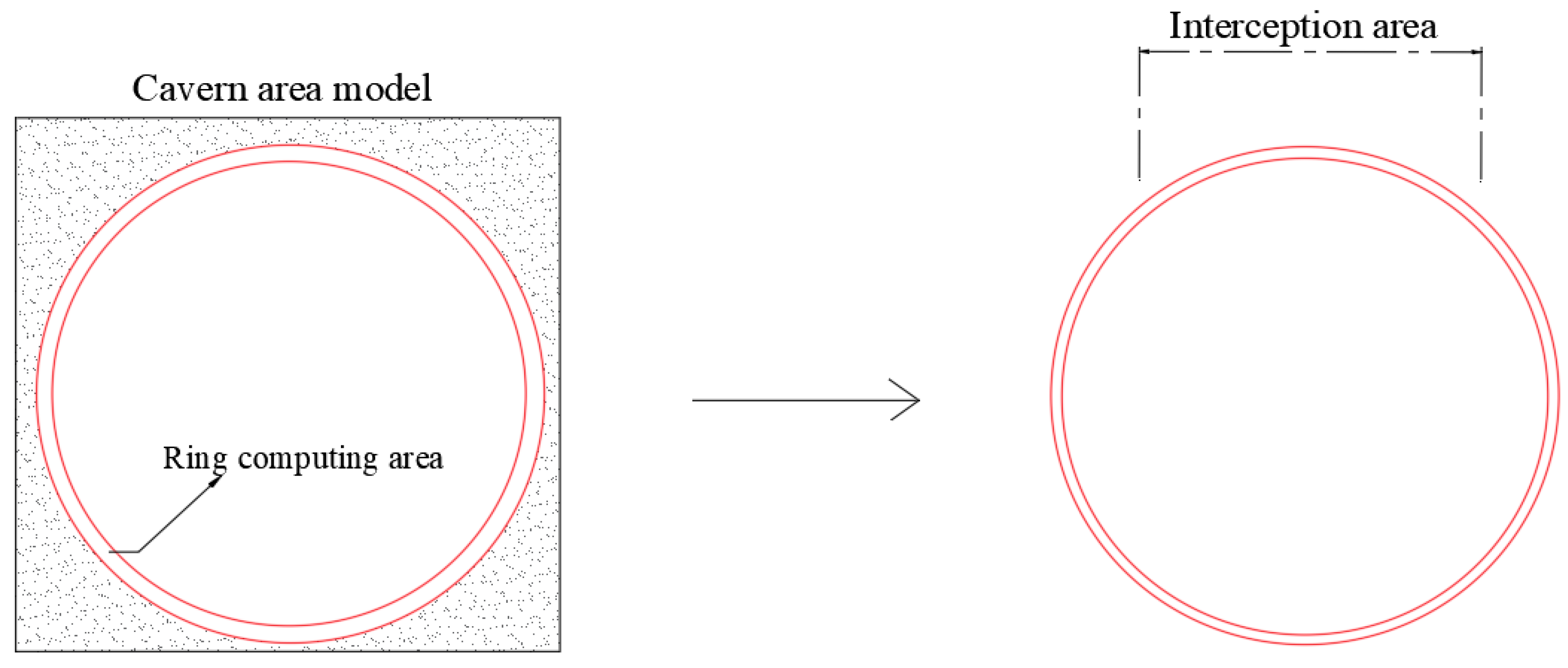




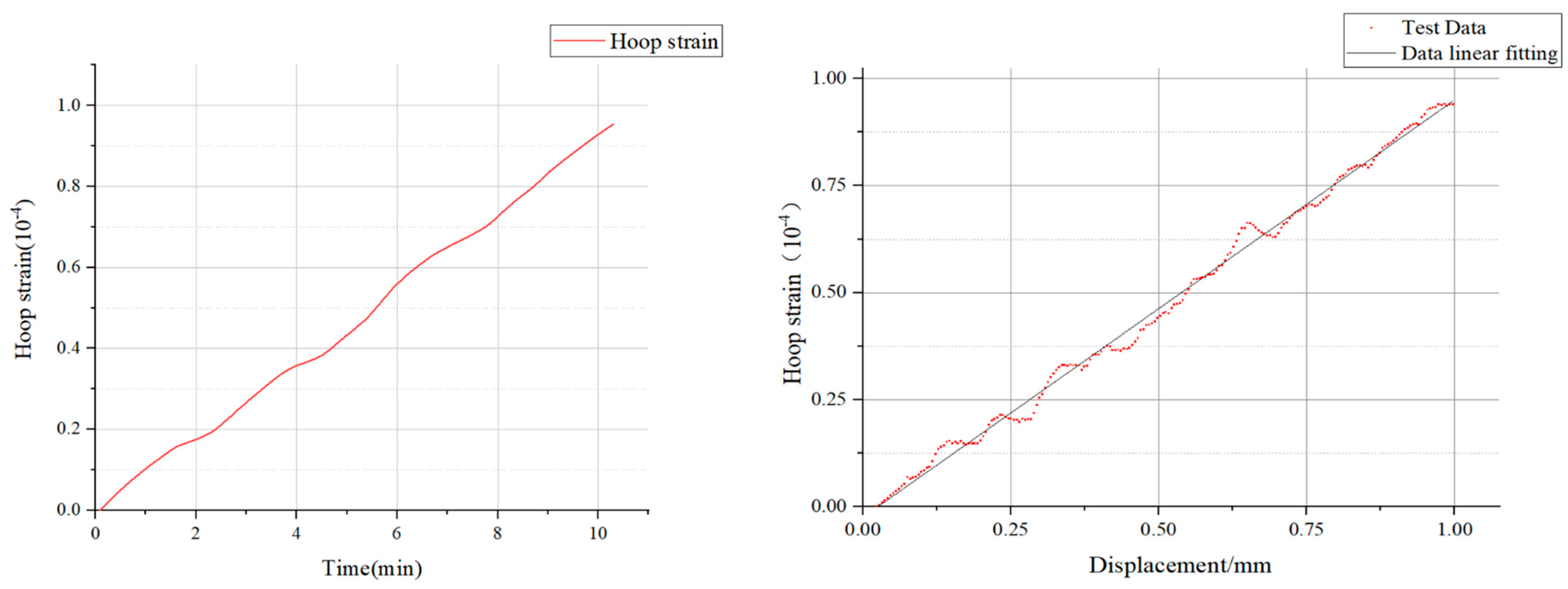
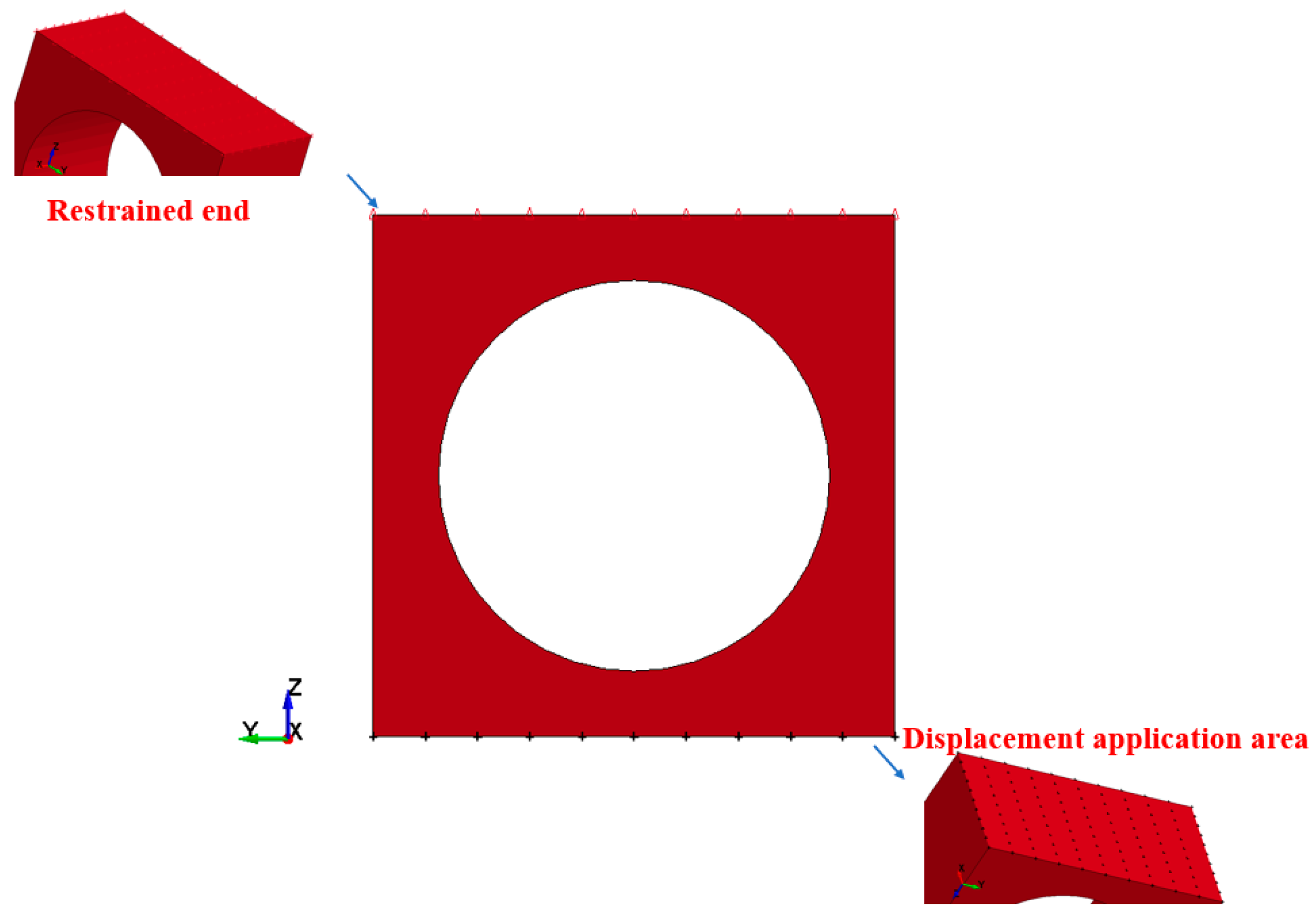


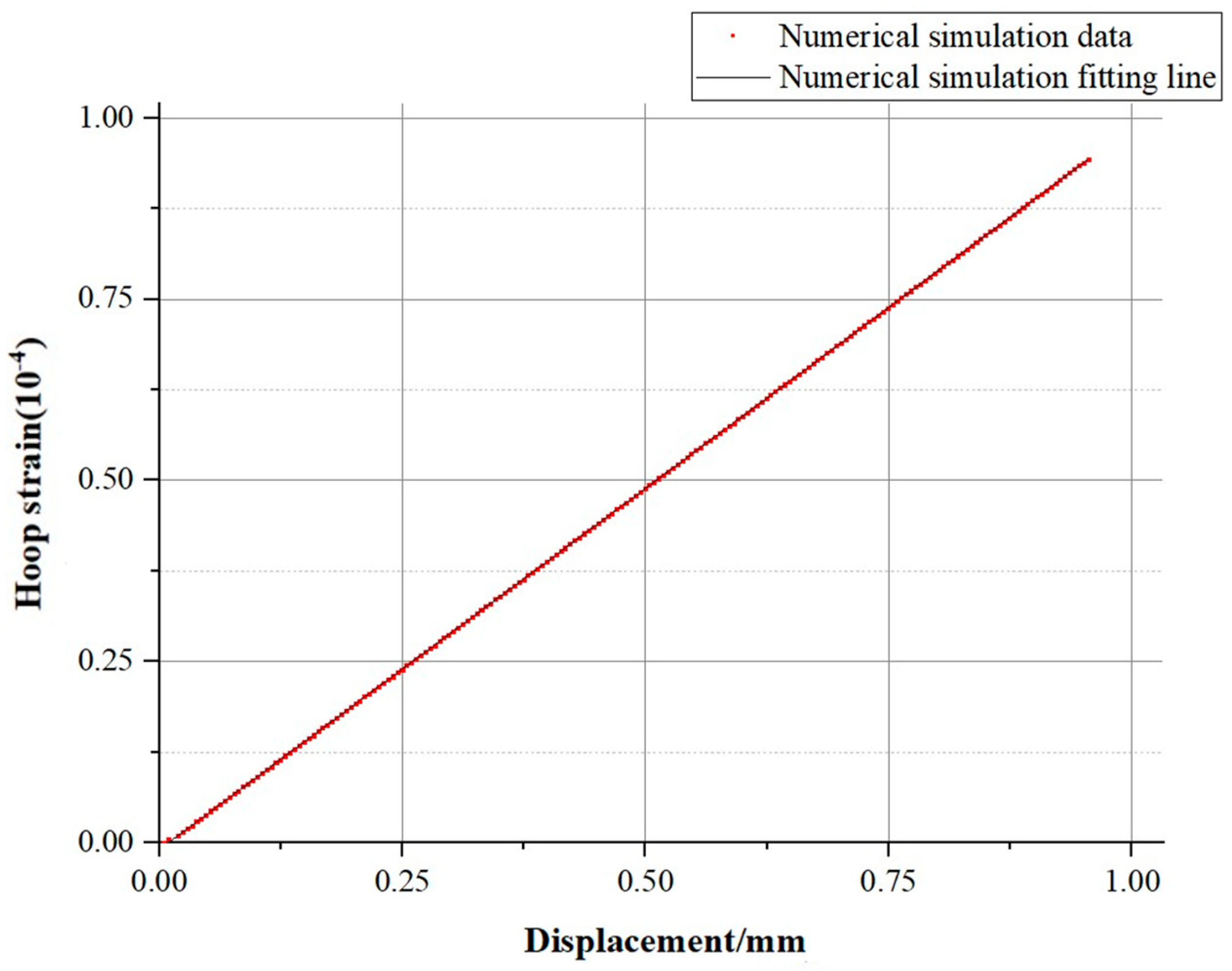


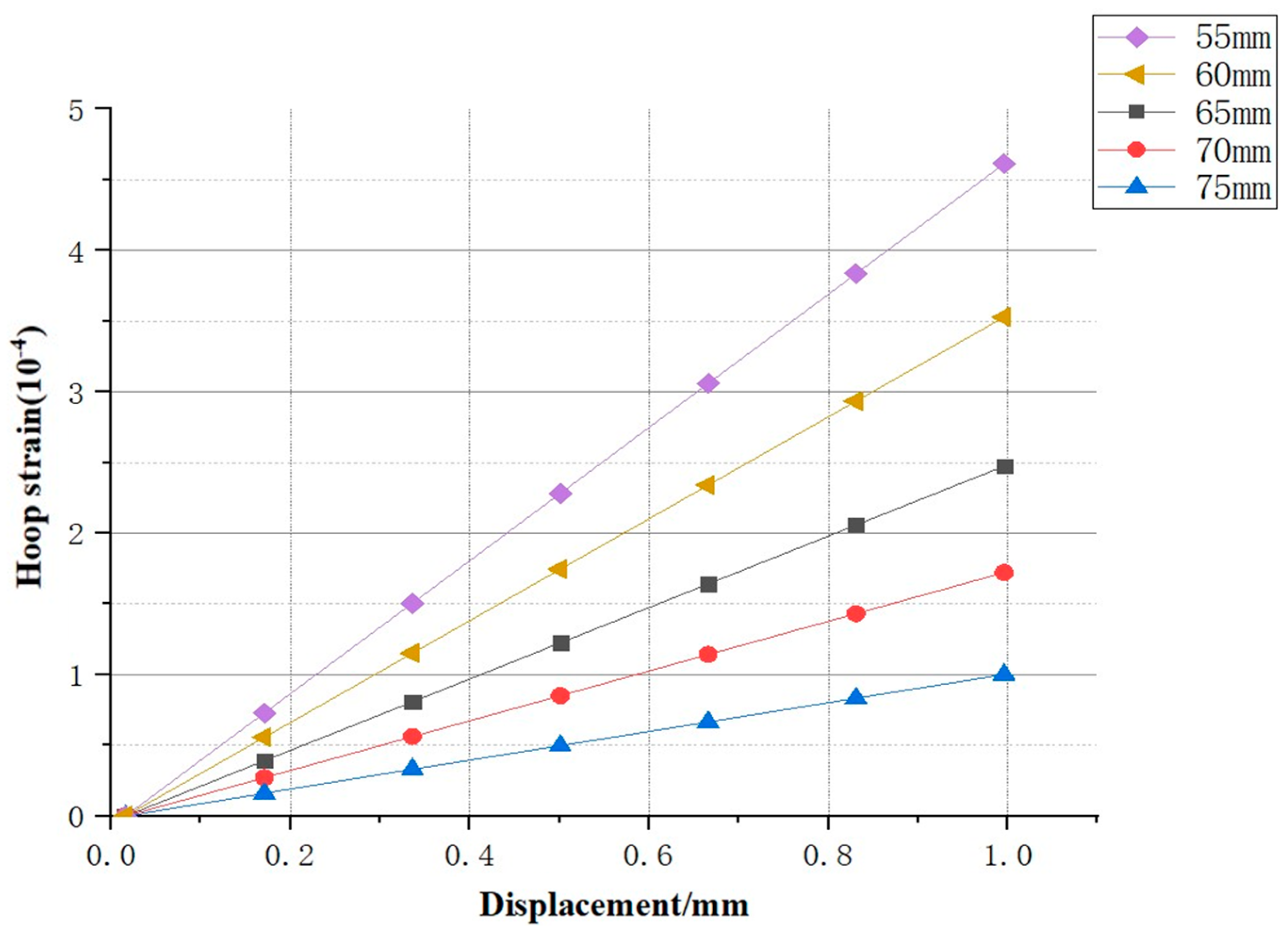
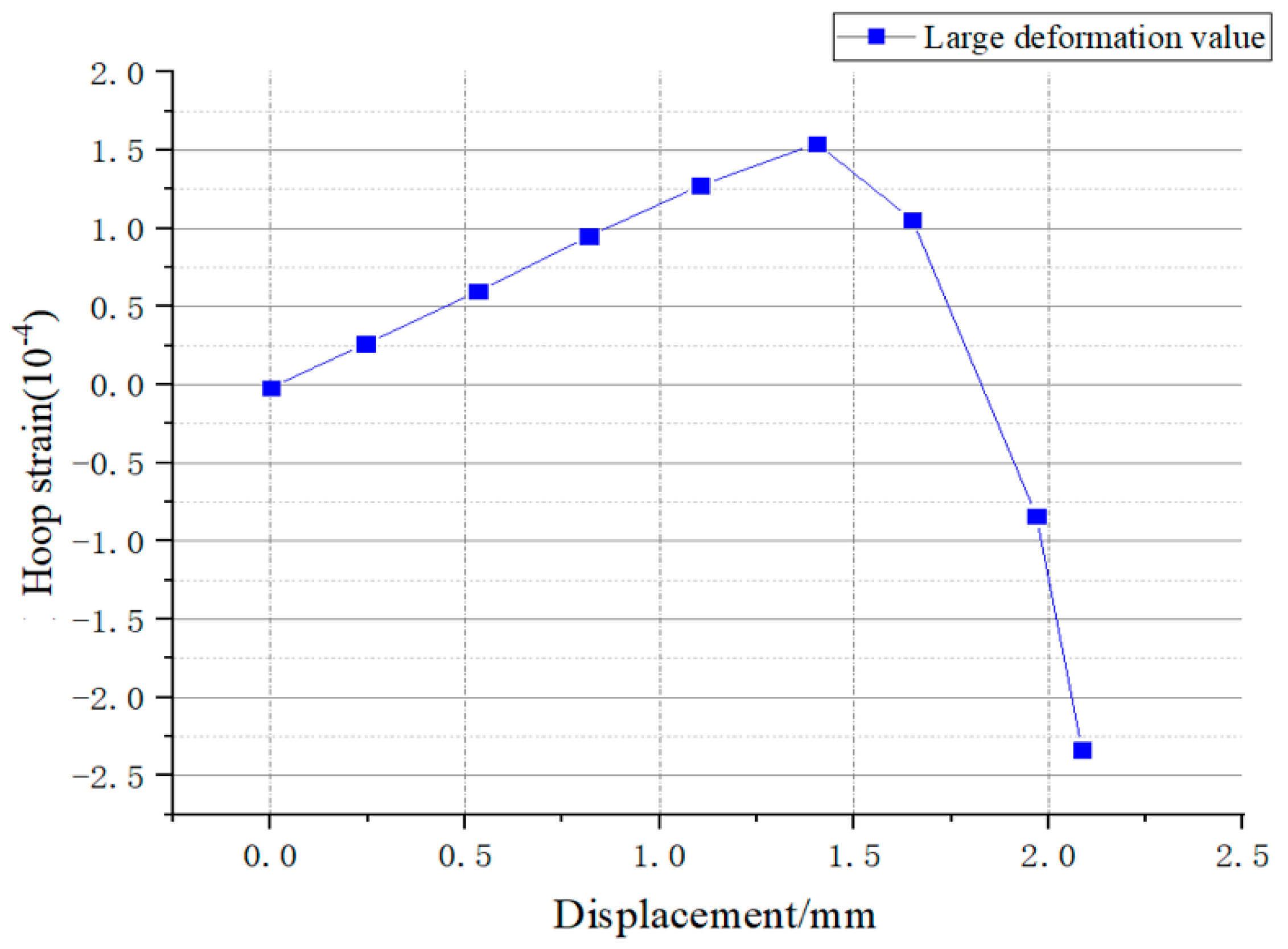
| Density (kg/mm3) | Shear Modulus (Gpa) | Uniaxial Compressive Strength (Gpa) |
|---|---|---|
| 16.7 | 0.035 |
| Number | Diameter of the Hole (mm) | Shear Modulus (Gpa) |
|---|---|---|
| N-1 (Initial) | 75 | 16.7 |
| N-2 | 75 | 10.7 |
| N-3 | 75 | 12.7 |
| N-4 | 75 | 14.7 |
| N-5 | 75 | 18.7 |
| N-6 | 75 | 20.7 |
| N-7 | 70 | 16.7 |
| N-8 | 65 | 16.7 |
| N-9 | 60 | 16.7 |
| N-10 | 55 | 16.7 |
| Number | Shear Modulus (Gpa) | Slope | Intercept | R2 |
|---|---|---|---|---|
| N-1 (Initial) | 16.7 | −4.678 × 10−6 | 0.997 | |
| N-2 | 10.7 | −4.709 × 10−6 | 0.989 | |
| N-3 | 12.7 | −4.684 × 10−6 | 0.996 | |
| N-4 | 14.7 | −4.655 × 10−6 | 0.994 | |
| N-5 | 18.7 | −4.630 × 10−6 | 0.988 | |
| N-6 | 20.7 | −4.615 × 10−6 | 0.995 |
| Number | Hole Diameters (mm) | Slope | Intercept | R2 |
|---|---|---|---|---|
| N-1 (Initial) | 75 | −9.67 × 10−5 | −4.67 × 10−6 | 0.997 |
| N-7 | 70 | −1.62 × 10−4 | −6.44 × 10−6 | 0.999 |
| N-8 | 65 | −2.43 × 10−4 | −7.21 × 10−6 | 1 |
| N-9 | 60 | −3.51 × 10−4 | −8.15 × 10−6 | 0.998 |
| N-10 | 55 | −4.69 × 10−4 | −9.05 × 10−6 | 0.999 |
Disclaimer/Publisher’s Note: The statements, opinions and data contained in all publications are solely those of the individual author(s) and contributor(s) and not of MDPI and/or the editor(s). MDPI and/or the editor(s) disclaim responsibility for any injury to people or property resulting from any ideas, methods, instructions or products referred to in the content. |
© 2025 by the authors. Licensee MDPI, Basel, Switzerland. This article is an open access article distributed under the terms and conditions of the Creative Commons Attribution (CC BY) license (https://creativecommons.org/licenses/by/4.0/).
Share and Cite
Wang, J.; Xiong, Z.; Li, S.; Lu, H.; Sun, M.; Li, Z.; Chen, H. Research on Displacement Monitoring of Key Points in Caverns Based on Distributed Fiber Optic Sensing Technology. Sensors 2025, 25, 2619. https://doi.org/10.3390/s25082619
Wang J, Xiong Z, Li S, Lu H, Sun M, Li Z, Chen H. Research on Displacement Monitoring of Key Points in Caverns Based on Distributed Fiber Optic Sensing Technology. Sensors. 2025; 25(8):2619. https://doi.org/10.3390/s25082619
Chicago/Turabian StyleWang, Jiangdong, Ziming Xiong, Sheng Li, Hao Lu, Minqian Sun, Zhizhong Li, and Hao Chen. 2025. "Research on Displacement Monitoring of Key Points in Caverns Based on Distributed Fiber Optic Sensing Technology" Sensors 25, no. 8: 2619. https://doi.org/10.3390/s25082619
APA StyleWang, J., Xiong, Z., Li, S., Lu, H., Sun, M., Li, Z., & Chen, H. (2025). Research on Displacement Monitoring of Key Points in Caverns Based on Distributed Fiber Optic Sensing Technology. Sensors, 25(8), 2619. https://doi.org/10.3390/s25082619











